Sting nematode is a common problem in Florida’s potato growing regions—mainly Northeast Florida, but also the Suwannee Valley and throughout Peninsular Florida. Left untreated, this nematode causes severe damage to potato as illustrated in Figures 1 and 2. Fumigation using Telone II at 6 gallons/acre is common and effective method for managing sting nematode on potato. As in most crops, profit margins are tight in potato; a few years ago a grower asked if it was possible to cut costs in a nematicide regime while retaining effective nematode management. That spurred the research described in this article.
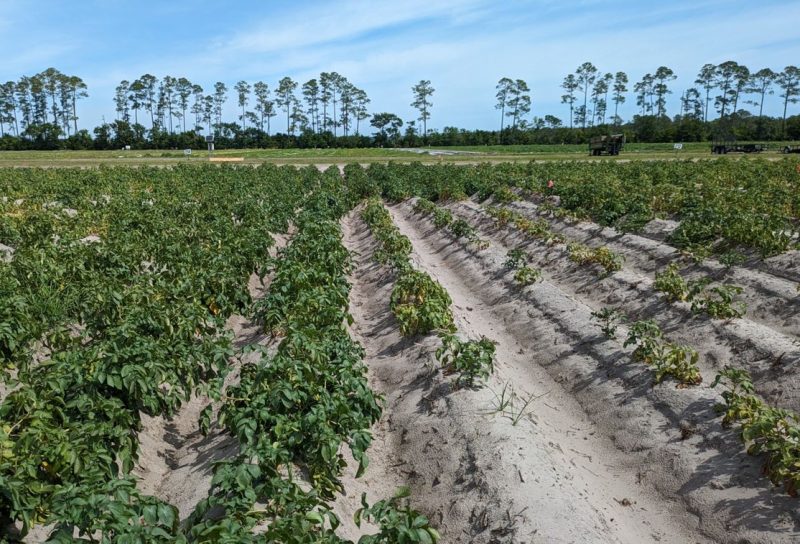
Figure 1. Severe stunting and reduced stand in a potato research plot due to sting nematode infestation. The affected plot was not treatment with nematicides and the surrounding plots were fumigated.
–

Figure 2. Severe stunting and reduced tuber set due to sting nematode infestation in an untreated plot (right) relative to more robust potato plants that were protected from sting nematode by fumigation (left).
–
Briefly, replicated small plot research trials were conducted at the Hastings Agricultural Education Center in 2023 and 2024. Nematicide treatments are described in Table 1 below. Most treatments were cheaper than the standard Telone II regime, except metam potassium treatments. Metam Potassium was included because it is one of the few fumigants available where 1,3-Dichloropropene is not the active ingredient, and there was little information about its efficacy against sting nematodes. In prior work, a high rate of metam potassium (45 gallons/acre) induced phytotoxicity on potato, so both a low and high rate were tested. Nematode counts, marketable yield, and total yield are reported. The marginal return ($/acre) is also reported. Briefly, marginal return is the change in income for a particular treatment relative to untreated (mean). This included crop value from treatment yields (estimated at $17.50/Count) and estimated product costs, but do not include labor or fuel costs for applying nematicides.
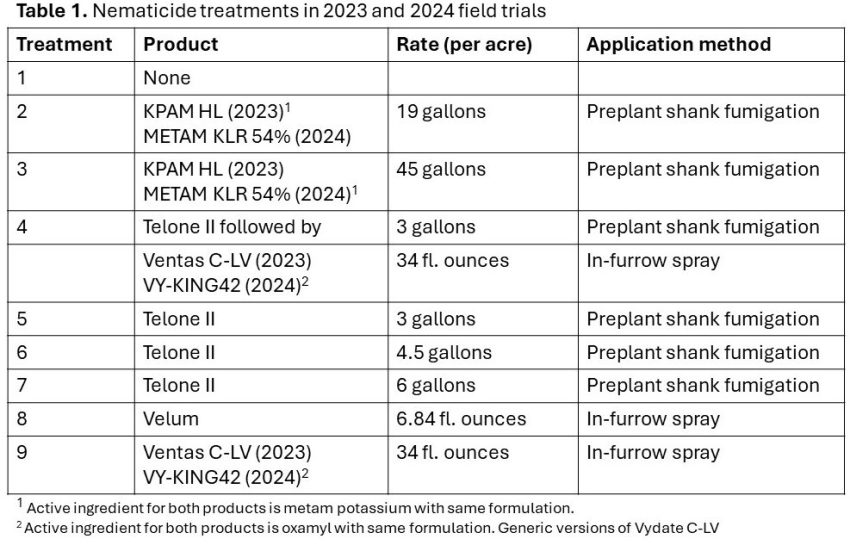 –
–
All fumigation treatments managed sting nematode populations
All fumigation treatments managed sting nematode abundances at midseason, which was 6 weeks after planting (Figure 3). This is typically the most important timing for evaluating nematicide efficacy as protecting the crop from nematode damage early in the season is the primary aim of nematicide application. By harvest, fumigation still generally managed nematode abundances relative to untreated, although control was better with metam potassium than some Telone II treatments. In-furrow nematicide treatments (Velum or oxamyl) did not manage sting nematode abundances.
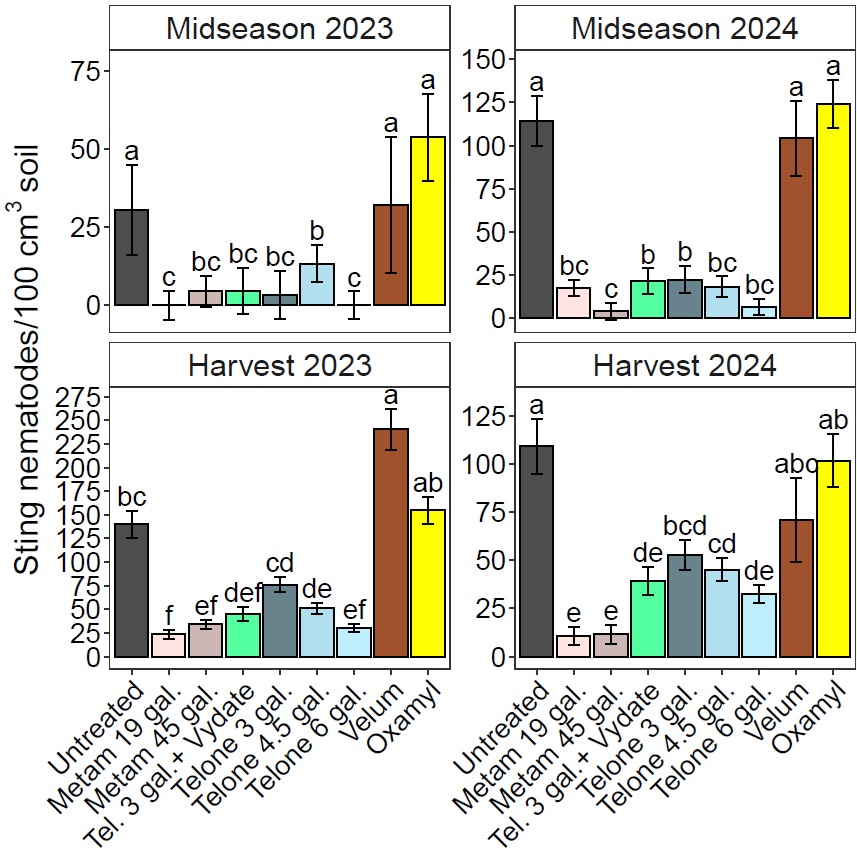
Figure 3. Sting nematode soil abundances as affected by nematicide treatments in 2023 and 2024 trials. Midseason was 6 weeks after planting. Treatments that do not share any letters are significantly different from each other (Fisher’s protected LSD, P<0.05).
–
Telone II at 6 gallons/a was the most consistently profitable treatment
Based on yield (Figures 4 and 5) as well as marginal return on investment (Figure 6), either Telone II at 4.5 or 6 gallons per acre consistently improved potato production. However, the 6 gallon rate would be a safer choice as it produced approximately $200/acre more than the 4.5 gallon rate in 2024. The 3 gallon rate of Telone II (with or without in-furrow oxamyl) was inconsistent. In sum, Telone II at 6 gallons remains the most reliable sting nematode management method based on this research, but reducing to a 4.5 gallon rate is a viable option for cutting costs.
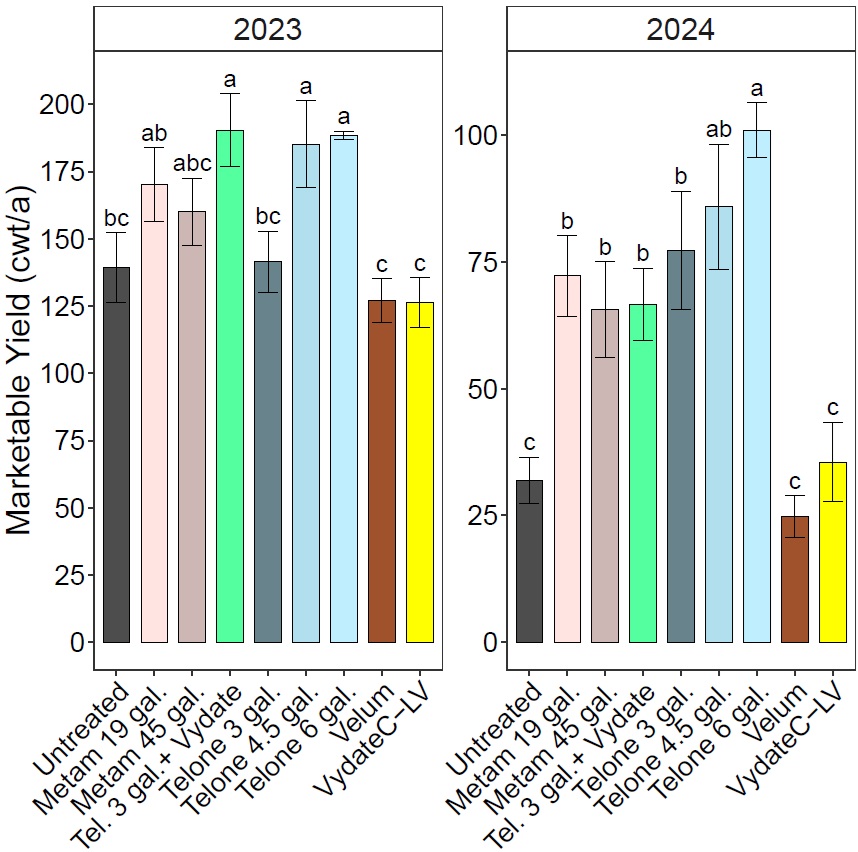
Figure 4. Marketable yield (Count/acre) as affected by nematicide treatments in 2023 and 2024 trials. Treatments that do not share any letters are significantly different from each other (Fisher’s protected LSD, P<0.05).
–

Figure 5. Total yield (Count/acre) as affected by nematicide treatments in 2023 and 2024 trials. Treatments that do not share any letters are significantly different from each other (Fisher’s protected LSD, P<0.05).
–
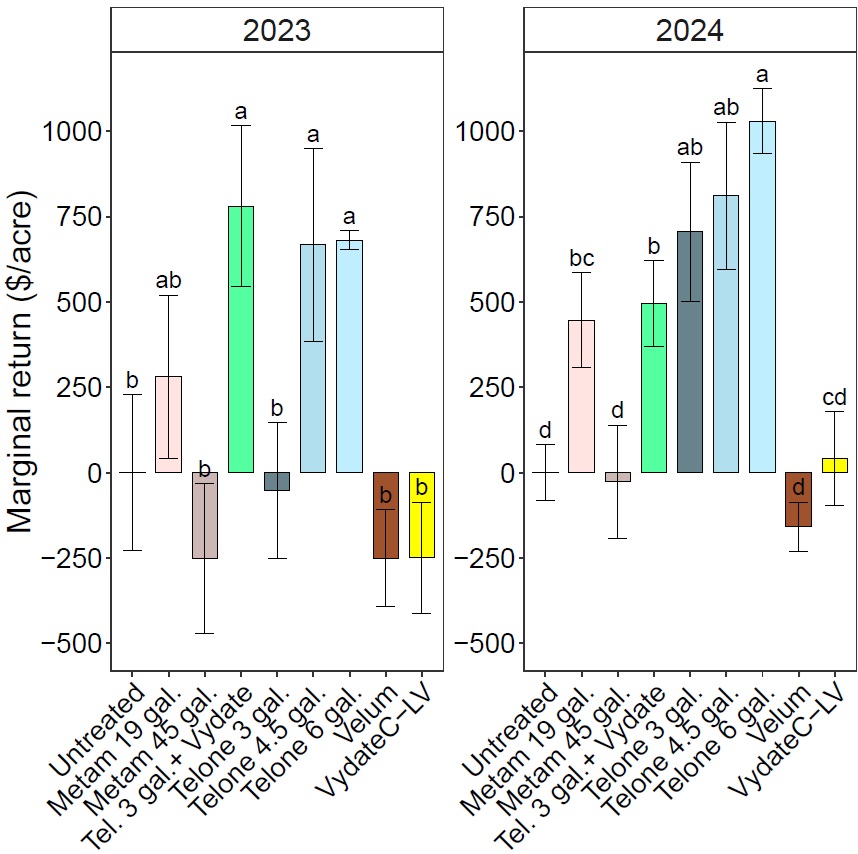
Figure 6. Marginal return on investment ($/acre) as affected by nematicide treatments in 2023 and 2024 trials. Marginal return is relative to the mean for untreated. Treatments that do not share any letters are significantly different from each other (Fisher’s protected LSD, P<0.05).
–
Metam potassium improves potato production, but less than Telone II
Yield for metam potassium treatments was roughly intermediate between Telone II at 6 gallons and untreated (Figures 4 and 5). Metam potassium at 19 gallons also had intermediate marginal return on investment, but the 45 gallons rate was not cost-effective due to higher product costs (Figure 6). A rate of 19 gallons metam potassium was the superior option. Telone II (at 4.5 or 6 gallons) was a more productive treatment than metam potassium, although they controlled nematode populations similarly. It is possible that this discrepancy was due to differences in sting nematode management that were too small to detect, slight phytotoxicity by metam potassium, or other factors. Metam potassium typically has efficacy against a broader range of pests (e.g. soil-borne diseases, weeds) than Telone II, so it is not likely due to control of other pests. While not as effective as common Telone II rates, this research showed that metam potassium can help with sting nematode management.
–
In-furrow nematicides were not effective for sting nematode
Consistent with their lack of sting nematode population management, in-furrow nematicides (Velum or oxamyl) did not improve potato yield (Figures 4 and 5) and therefore were not profitable to apply (Figure 6). In 2023, supplementing Telone II at 3 gallons with in-furrow oxamyl did improve yield and profitability relative to Telone II at 3 gallons alone, but this was inconsistent as there was no benefit in 2024. Lack of efficacy may be due in part to limited soil coverage of these treatments and abundant mixing of soil through tillage, even after planting. A regime of in-furrow and foliar oxamyl applications is still recommended for control of Corky Ringspot Disease, which is vectored by stubby-root nematodes. More work would be needed to determine if other application methods or timings of liquid nematicides would be more useful in managing sting nematode.
–
Conclusion
Based on the study, the current nematicide practice is still the most consistently effective method for managing sting nematode. However, growers that chose to reduce Telone II rates or use metam potassium due to its broader control of other pests can still expect adequate sting nematode management. Work will continue to identify effective alternatives for sting nematode management, including both nematicides and cultural practices. For more information on nematode management in Florida potato, see the following EDIS publication: Nematode Management in Potatoes
